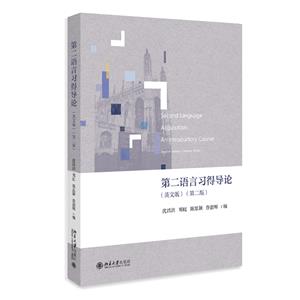-
>
中医基础理论
-
>
高校军事课教程
-
>
思想道德与法治(2021年版)
-
>
毛泽东思想和中国特色社会主义理论体系概论(2021年版)
-
>
中医内科学·全国中医药行业高等教育“十四五”规划教材
-
>
中医诊断学--新世纪第五版
-
>
中药学·全国中医药行业高等教育“十四五”规划教材
第二语言习得导论(英文版)(第二版) 版权信息
- ISBN:9787301339954
- 条形码:9787301339954 ; 978-7-301-33995-4
- 装帧:平装
- 册数:暂无
- 重量:暂无
- 所属分类:>>
第二语言习得导论(英文版)(第二版) 本书特色
本书是《第二语言习得导论(英文版)》的再版。本次修订,补充了有关第二语言习得的*新发展动态的内容,全书本着理论联系实际、重点突出的原则,力求具有实用性和可操作性。
全书体例清晰,内容详实,本次修订新增了三个单元的内容,并对一些过时的概念做了删减,加入了第二语言习得研究领域的*新研究成果。
第二语言习得导论(英文版)(第二版) 内容简介
本书是《第二语言习得导论(英文版)》的再版。本次修订,补充了有关第二语言习得的近期新发展动态的内容,全书本着理论联系实际、重点突出的原则,力求具有实用性和可操作性。书中不仅讨论了第二语言习得的学科定位、性质以及主要涵盖内容,而且详细阐释了第二语言习得的过程,并从教学法的角度出发,探讨了课堂环境中的二语习得,*后指出了二语习得发展前景的多视角性质。本书可以作为广大外语教师、研究人员和高等学校外语专业本科生和研究生的教材或参考书,以便他们了解该学科的知识体系和国内外近期新研究动态,发现研究问题。
第二语言习得导论(英文版)(第二版) 目录
Chapter 1 Introduction: Key Concepts and Issues in SLA …………………1
1.1 Language Acquisition and SLA ………………………………1
1.2 Some Definitions of SLA ……………………………………2
1.3 Some Structural Characteristics of SLA ………………………3
1.4 The Literature on the Theories of SLA ………………………5
1.5 A Theoretical Approach Proposed by Spolsky ………………6
1.6 A Five-staged Model of SLA by Gass ………………………8
1.7 Theoretical Applications to L2 Teaching and Learning ………9
1.8 Some Distinctions in the Field of SLA Research ……………10
1.9 Conclusion ……………………………………………………17
Chapter 2 Views on Language, Learning and Learner ……………………20
2.1 Views on the Nature of Language ……………………………20
2.2 Views of the Language Learning Process ?C L1 Versus L2 ……25
2.3 Views of the Second Language Learner ………………………34
2.4 Conclusion ……………………………………………………40
Chapter 3 An Introduction to Language Acquisition ………………………42
3.1 Introduction ……………………………………………………42
3.2 Developmental Patterns in L1 Acquisition ……………………42
3.3 The Controversy Between Behaviorist and Mentalist Models …51
3.4 Developmental Patterns in L2 Acquisition …………………53
3.5 Conclusion ……………………………………………………62
Chapter 4 Recent History of SLA Research ………………………………… 64
4.1 Introduction …………………………………………………… 64
4.2 The Early Studies on Language Acquisition (to 1960s) ……… 65
4.3 The Following-up Studies in the 1970s and 1980s …………… 70
4.4 The Recent Studies on L2A (beyond 1990s) ………………… 78
4.5 Conclusion …………………………………………………… 81
Chapter 5 The UG Approach to Language Acquisition …………………… 83
5.1 Introduction …………………………………………………… 83
5.2 UG for Language Acquisition ………………………………… 83
5.3 Arguments from L1 Acquisition ……………………………… 88
5.4 What Does UG Consist of ? ………………………………… 92
5.5 Evaluation of UG-based Approaches to SLA ………………… 95
5.6 Conclusion …………………………………………………… 98
Chapter 6 Cognitive Approaches to SLA ………………………………… 101
6.1 Introduction ………………………………………………… 101
6.2 Two Main Groups of Cognitive Theorists ………………… 102
6.3 Processing Approaches …………………………………… 103
6.4 Connectionism ………………………………………………110
6.5 Theories of L2 Processing ……………………………………112
6.6 Evaluation of Cognitive Approaches to L2 Learning …………115
6.7 Conclusion ……………………………………………………117
Chapter 7 Some Other Perspectives on SLA …………………………………119
7.1 Introduction ……………………………………………………119
7.2 Functional Perspectives on L1 Learning and SLA ……………119
7.3 Functionalist Contributions to an Understanding of SLA … 122
7.4 Sociocultural Perspectives on SLA ………………………… 124
7.5 Sociolinguistic Perspectives on SLA ……………………… 129
7.6 Conclusion ………………………………………………… 134
Chapter 8 Input, Interaction and Output in SLA………………………… 136
8.1 Introduction ………………………………………………… 136
8.2 Input and Interaction in L1 Acquisition …………………… 137
8.3 Input and Interaction in SLA ……………………………… 138
8.4 Output in SLA ……………………………………………… 144
8.5 Theorizing Input, Interaction and Output Research ……… 146
8.6 Feedback, Recasts and Negative Evidence in SLA ……… 148
8.7 Evaluation: the Scope of Interactionist Research ………… 152
8.8 Conclusion ………………………………………………… 153
Chapter 9 Varied Perspectives on Interlanguage ………………………… 155
9.1 An Introduction to Interlanguage ………………………… 155
9.2 Social Aspects of IL ……………………………………… 157
9.3 Discourse Aspects of IL …………………………………… 160
9.4 Psycholinguistic Aspects of IL …………………………… 166
9.5 Conclusion ………………………………………………… 175
Chapter 10 L2 Teaching Approaches from CLT to TBLT ………………… 177
10.1 The Distinction of Language Teaching Approaches and
Methods ………………………………………………… 177
10.2 The Communicative Approach and CLT in SLA Studies … 183
10.3 The TBLT and TBLL in SLA Studies …………………… 191
10.4 Conclusion ……………………………………………… 199
Chapter 11 The SLA Research on Teaching Four Language Skills ……… 202
11.1 The Connection of Four Language Skills and Language
Work ……………………………………………………… 202
11.2 Receptive Skills and Productive Skills Among the Four
Language Skills ………………………………………… 203
11.3 Integrating the Four Skills in a Language Classroom …… 209
11.4 Balancing and Integrating the Four Language Skills …… 216
11.5 Pedagogical Principles and the Four Language Skills …… 218
11.6 Conclusion ……………………………………………… 219
Chapter 12 An Introduction to Teaching Four Language Skills ………… 221
12.1 A Framework of CC Integrating the Four Skills ………… 221
12.2 Teaching L2 Listening …………………………………… 223
12.3 Teaching L2 Reading …………………………………… 228
12.4 Teaching L2 Speaking …………………………………… 233
12.5 Teaching Writing ………………………………………… 238
12.6 Conclusion ……………………………………………… 242
Chapter 13 Researches on L2 Classroom Practice (I) …………………… 244
13.1 Introduction ……………………………………………… 244
13.2 An Introduction to the History of L2 Teaching Methods … 246
13.3 Cross-language Competition Between L1 and L2 ……… 249
13.4 Some Methods Used in L2 Classroom Research ………… 251
13.5 Data Collection and Data Analysis ……………………… 256
13.6 Conclusion ……………………………………………… 261
Chapter 14 Researches on L2 Classroom Practice (II) …………………… 263
14.1 Direct Involvement of Classroom Interaction Research … 263
14.2 An Introduction to Classroom Interaction ……………… 263
14.3 Types of Language Use in Classroom Interaction ……… 267
14.4 Turn-taking in Classroom Discourse …………………… 269
14.5 Differences Between Classroom and Naturalistic Discourse … 270
14.6 The Teacher’s Role in Classroom Interaction …………… 271
14.7 Learner Participation ……………………………………… 275
14.8 Classroom Interaction in the L2 Learning ……………… 276
14.9 The Relationship Between Classroom Interaction and SLA … 279
14.10 Conclusion ……………………………………………… 280
Chapter 15 Conclusion ……………………………………………………… 283
15.1 A Brief Review of the Book ……………………………… 283
15.2 An Integrated View of SLA Research …………………… 284
15.3 Main Achievements of Recent SLA Studies ……………… 285
15.4 SLA Research and Language Education ………………… 287
15.5 Future Directions for SLA Research ……………………… 289
REFERENCES ………………………………………………………………… 293
第二语言习得导论(英文版)(第二版) 作者简介
沈昌洪、郑虹、陈思颖、鲁韶辉
----------------------------
沈昌洪,英语语言文学硕士,杭州师范大学外国语学院教师,研究方向:英语语言学,第二语言习得,英语教师教育。主编、参编著作十余部,发表学术论文数十篇。
郑虹, 教育学、管理学双硕士,经亨颐教育学院副教授;研究方向:英语课程与教学论,英语教师教育。长期指导师范生教学技能大赛,所指导学生在各类教学比赛获奖20余项。
陈思颖,杭州师范大学外国语学院副教授、博士,硕士生导师。研究方向:英语教育论,英语教师教育,主持并参与多个省部级项目,发表相关论文十余篇。
鲁韶辉,男,硕士,浙江省杭州高级中学高级教师,先后获得过省市级优质课评比一、二等奖和市级教研先进个人、市级优秀教师、省级教学骨干等荣誉称号。
- >
诗经-先民的歌唱
诗经-先民的歌唱
¥13.5¥39.8 - >
企鹅口袋书系列·伟大的思想20:论自然选择(英汉双语)
企鹅口袋书系列·伟大的思想20:论自然选择(英汉双语)
¥6.3¥14.0 - >
罗曼·罗兰读书随笔-精装
罗曼·罗兰读书随笔-精装
¥20.3¥58.0 - >
人文阅读与收藏·良友文学丛书:一天的工作
人文阅读与收藏·良友文学丛书:一天的工作
¥14.7¥45.8 - >
新文学天穹两巨星--鲁迅与胡适/红烛学术丛书(红烛学术丛书)
新文学天穹两巨星--鲁迅与胡适/红烛学术丛书(红烛学术丛书)
¥9.9¥23.0 - >
中国人在乌苏里边疆区:历史与人类学概述
中国人在乌苏里边疆区:历史与人类学概述
¥34.1¥48.0 - >
龙榆生:词曲概论/大家小书
龙榆生:词曲概论/大家小书
¥13.0¥24.0 - >
回忆爱玛侬
回忆爱玛侬
¥23.0¥32.8





















